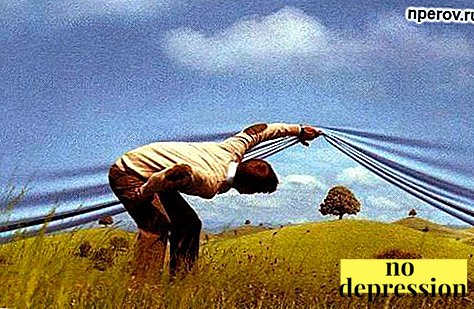Via proper breathing you can calm your nerves, heal the body or unleash your own creative potential.
Therefore, people are actively studying and using various breathing techniques.
What is it and what is it for?

Holotropic breathing - This is a psychotherapeutic practice that allows you to work out the unconscious material, launching the processes of self-knowledge and self-healing.
The person at the time of performing the technique of holotropic breathing plunges into unusual states.
Technique holotropic breathing is part of "Big Three breathing techniques"actively used in psychotherapy.
Rapid breathing allows you to achieve hyperventilation of the lungs and oxygen poisoning of its cells. A person has a feeling of mild intoxication and euphoria.
With the help of such an “artificial removal of the internal and external frames,” the mechanism of self-regulation and self-correction of the organism. Consciousness seeks to restore natural harmony, at the time getting freedom from the vigilant dictator (conscious element).
Who are the authors of this technique?
The author of holotropic breathing appears Stanislav Grof (born June 1, 1931). The scientist researched altered states of consciousness for over 40 years.
Education doctor (clinician psychiatrist) allowed Stanislav to participate and lead innovative projects.
So in 1961, the scientist became the head of a study whose goal was track the positive effects of LSD and psychedelics for the correction of mental pathologies.

After a series of experiments, Grof and his wife, Cristina, set out to abandon the use of psychoactive substances (also due to the widespread ban at the legislative level).
The main task was to develop a methodology that allows use the hidden resources of the body and run self-correction.
So the idea of intensive breathing was born, and in 1975 holotropic technique began to gain popularity among doctors and people interested in self-development.
The idea of group sessions and pairing partners arose quite by accident. Being an instructor, Grof was unable to work personally with patients for health reasons, as an alternative he offered to split the group into pairs and hold two breathing sessions.
In addition, each of the partners should act alternately as a holonavt and as an assistant.
After the experiment, Grof noticed powerful positive results, surpassing the previously noted therapeutic effect.
How is this procedure performed?
The effectiveness of the technique is based on four components.:
- Intense deep breathing.
- Stimulating or stimulating background music.
- Immersion on the unconscious level (spontaneous method).
- Study and analysis of the result.

The most effective method of using holotropic therapy is group method. Each patient (holonaut) with the help of a psychotherapist selects a comfortable number of sessions (up to 12). One session lasts from two to eight hours.
Before you begin to practice holonavty pass a detailed briefing. In this case, the instructor introduces the session participants with breathing technique, therapeutic effect, indications and contraindications, instructions for implementation, and also explains in detail what the holonaut will feel during the session.
Holotropic breathing differs from the usual breathing frequency and depth (more intense indicators). But there are no special timings or technologies that should guide the holonavt.
The speed and method of breathing each session participant individually selectsguided by personal feelings and experiences. Instructor intervention is minimized.
Active intervention is permissible only if there are problems with a holonavt (airway spasms, panic attacks, pain, a direct request for help, etc.).

Required element of the session - background acoustic stimulation.
Music (or alternative natural sounds) should maintain and complement every stage of holotropic practice, developing from a stimulating impulse to a dynamic and dramatic one, and then to a climax and a subsequent transition to a meditative sound.
A holotropic session most often occurs by the method of pair division in groups. Partner acting as a sitter (assistant) must come to your role responsibly. He must provide holotrope security, give a sense of stability and care.
Actively interfere with the process and distract your partner during breathing is impossible. But at the same time it is necessary to provide assistance if the holotrop wants to get up, drink a glass of water or ask for a towel.
The sitter should also remind the partner to maintain the rhythm of breathing, if the holonaut forgets about it plunging into the depths of their experiences.
After the end of the breathing session, the holotrope moves to the stage of working with the body. In a state of altered consciousness, he expressing itself and throwing emotions, relieves tension.
The curator creates conditions that allow a person to open up and complete the process of resolving internal conflicts and experiences.

After the session participants have finished working with the body, the curator announces break.
After the break, all participants in the session return to therapy, discussing their experiences and feelings received during the therapy.
The curator does not explain and does not analyze the words of holotropes. The main task of the group discussion is study of experiences.
Who is indicated and who is contraindicated therapy?
Special indications to holotropic therapy does not exist.
She may be appointed by a leading patient specialist if he believes that holotropic sessions will help to cope with any problems or ease the condition of the person.
But an individual can take part in holotropic therapy with the aim of self-development and spiritual growth, the acquisition of new experience and the activation of hidden resources.
Contraindications:
- cardiovascular diseases;
- recent surgery or fracture;
- pregnancy;
- general weakness of the body against the background of the disease;
- epilepsy;
- increased intraocular pressure;
- psychopathology;
- paranoid and manic states.

It is important to take into account the emotional background. If a person experiences a fear of a session, is acutely afraid of losing control, or has difficulty distinguishing between internal and external processes, therapy may have a negative effect.
Is it possible to do at home?
How to breathe on your own? At home the process boils down to three stages:
- Setting deep and slow breathing for 10 minutes.
- Intensive breathing session without interruptions between inhalations and exhalations (duration of the stage is 40-60 minutes).
- Gradual return to a habitual rhythm of breath within 20 minutes.

Holotropic breathing (timing and intensity) steals up intuitively.
To conduct therapy alone is impossible, since the key stage is the discussion of the experience with the mentor.
So to home practice will have to attract a person.
Also need special music. You can create a playlist from the audio recordings offered for holotropic therapy on the network. At home session can be reduced to an hour.
You must comply with safety regulations.:
- to involve in the process an assistant familiar with the technique and effect of the procedure;
- remove jewelry, goggles, movement of clothing;
- remove from the area in which the therapy will take place, potentially traumatic and dangerous objects (hide the glassware, close the corners, etc.).
You can compensate for working with a specialist by drawing a mandala. The process does not require mentoring and is a free creative outpouring.
results

What gives holotropic breathing?
The most important plus holotropnoy therapy - immersion in the unconscious, not susceptible to analysis and correction.
As the process of self-regulation starts, a person does not have to go through the traumatic experience of “identifying” painful points in the subconscious. Getting rid of the negative happens in the most comfortable way - through creativity and impulses.
Holotropic therapy is high-speed technique, which gives tangible results after the first session.
Holotropic breathing allows you to correct anxious states by working through the problem and changing attitudes towards it. The benefits of HD are obvious and in the case when a person is under stress due to circumstances that cannot be affected.
Another confirmed effect of holotropic breathing is exacerbation of perception. Paints become more expressive and brighter, smells and tastes sharper, breathing is deeper.
Another one positive side of therapy - satisfaction of the inner child, who perceives the state of altered consciousness as a miracle.
Through holotropic breathing, a person frees up the voice of his subconscious, allowing depressed emotions to express themselves.
Creative potential is revealed rights (both due to the restoration of communication with the unconscious element, and due to obtaining a new, unique experience).

False stereotypes are crumbling, releasing a lot of energy. The angle of perception of the surrounding world is changing, allowing you to notice something new in the outlines and images of familiar things.
Holotropic therapy is based on the idea of the uniqueness and uniqueness of individual experiences person
And since the curator (leader / specialist) does not offer the holotrope his own interpretation of the sensations experienced during the session, the substitution of concepts is not possible. Those. man will not have a false idea of his own feelings.
After holotropic therapy a person becomes more tolerant. He comes to state of balance and instead of criticism chooses the position of compassion / participation.
it positively reflected on the sphere of personal relationships. Blocks and clips that prevent the creation of love and friendship contacts, successful and fruitful interaction with others are lost.
In order to understand how holotropic therapy is right for you, you need to take part in the session and experience the positive and negative aspects on your own experience.
At the same time, it is better to start with group therapy. Home holotropnaya practice, without due experience, may disappoint with its inefficiency.
About holotropic breathing in this video:



